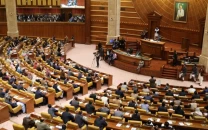Punjab aims for 7% growth by 2023
Launches strategy focused on creating average of 1.20m new jobs annually over next five years

Punjab Chief Minister Usman Buzdar. PHOTO: FILE
The Punjab government launched its growth strategy for the next five years (2018-2023), with an ambitious vision of provincial bureaucracy and few senior economists, particularly if examined in the current context of the country’s overall economy.
The provincial government hopes to achieve a globally connected and competitive Punjab with sustainable economic growth driven through a dynamic private sector. It is aiming for an efficient public sector, productive human capital and a regionally equalised development footprint by 2023.
Punjab to launch growth strategy
The previous policy prepared by the PML-N government (2015-18) also put forward some ambitious goals, and claimed to achieve 8% growth rate by 2018. The incumbent government is claiming to achieve 7% growth rate by 2023.
According to the report, none of the goals set by previous government for the period 2015-18 were achieved. The province achieved growth rate of 5.4% compared to the targeted 8%, while private sector investments increased to $15.3 billion in 2017-18 against the target of $17.5 billion.
The province only managed to create 830,000 jobs per annum against the target of one million. It also failed to increase its export base as the overall export volume of Pakistan remained depressed during that period. Of the 38 Millennium Development Goals, Punjab achieved only nine having little success in narrowing the security gap with regional neighbours.
The last policy was set when Pakistan’s GDP was moving towards 5% growth, whereas the current policy has been launched when local as well as international financial institutions are predicting a GDP growth of merely 3% for coming years.
Punjab finds it difficult to show Rs148b surplus this year
Nevertheless, it has been written in the strategy more than once that the targets of the new strategy are dependable with the national targets set by the government, highlighting that, if Islamabad fails to achieve its targets so does Punjab. Apart from an ambitious growth rate, the province plans to create an average of 1.20 million new jobs annually over the next five years, thereby contributing 60% to the national target of 10 million jobs.
To sustain growth, the Punjab government has been investing heavily in infrastructure such as roads, energy, mass-transit and provision of social services such as education and health. This time the strategy has identified five main pillars of growth in Punjab. Firstly, the strategy requires increased focus on agriculture and the SME sectors, as Punjab has clear significant comparative advantage in these sector as compared to the national economy. Secondly, it emphasises private sector development as the main engine of growth and provides detailed road map for horizontal and vertical interventions to address key constraints.
Thirdly, formation of human capital takes the place of the central pillar in the strategy due to its significant direct and indirect impact on growth. The strategy using the growth model has presented the most optimal allocation of public investment (ADP) for the province in terms of growth outcomes.











1726134115-0/BeFunk_-(41)1726134115-0-208x130.webp)







COMMENTS
Comments are moderated and generally will be posted if they are on-topic and not abusive.
For more information, please see our Comments FAQ